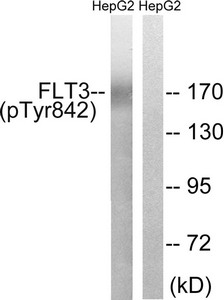
Western blot analysis of extracts from HepG2 cells treated with EGF using FLT3 (Phospho-Tyr842)) Antibody.The lane on the right is treated with the antigen-specific peptide.
Phospho-FLT3 (Tyr842) Antibody
CSB-PA254158
ApplicationsWestern Blot, ELISA
Product group Antibodies
ReactivityHuman, Mouse
TargetFLT3
Overview
- SupplierCusabio
- Product NamePhospho-FLT3 (Tyr842) Antibody
- Delivery Days Customer20
- ApplicationsWestern Blot, ELISA
- CertificationResearch Use Only
- ClonalityPolyclonal
- ConjugateUnconjugated
- Gene ID2322
- Target nameFLT3
- Target descriptionfms related receptor tyrosine kinase 3
- Target synonymsCD135; CD135 antigen; fetal liver kinase 2; FL cytokine receptor; FLK2; FLK-2; fms related tyrosine kinase 3; fms-like tyrosine kinase 3; growth factor receptor tyrosine kinase type III; receptor-type tyrosine-protein kinase FLT3; stem cell tyrosine kinase 1; STK1
- HostRabbit
- IsotypeIgG
- Protein IDP36888
- Protein NameReceptor-type tyrosine-protein kinase FLT3
- Scientific DescriptionFLT3 encodes a class III receptor tyrosine kinase that regulates hematopoiesis. The receptor consists of an extracellular domain composed of five immunoglobulin-like domains, one transmembrane region, and a cytoplasmic kinase domain split into two parts by a kinase-insert domain. The receptor is activated by binding of the fms-related tyrosine kinase 3 ligand to the extracellular domain, which induces homodimer formation in the plasma membrane leading to autophosphorylation of the receptor. The activated receptor kinase subsequently phosphorylates and activates multiple cytoplasmic effector molecules in pathways involved in apoptosis, proliferation, and differentiation of hematopoietic cells in bone marrow. Mutations that result in the constitutive activation of this receptor result in acute myeloid leukemia and acute lymphoblastic leukemia. Small D., Proc. Natl. Acad. Sci. U.S.A. 91:459-463(1994). Rosnet O., Blood 82:1110-1119(1993). Rosnet O., Genomics 9:380-385(1991).
- ReactivityHuman, Mouse
- Storage Instruction-20°C or -80°C
- UNSPSC12352203
